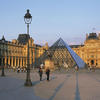More about The Crucifixion
- All
- Info
- Shop

Contributor
In the last days of the Venetian Republic, Verona lost one of its greatest artistic assets, Mantegna's Crucifixion, also known as The Calvary, to one of the most notorious curators in European history: Napoleon.
Official sources on the work don't usually mention that it was part of the spoils of war filched by the rampaging French Republic, because the Louvre is a big name, and they're okay with the fact that the people of Verona have become accustomed to looking at a Paolino Caliari copy of this work in its original home, in the predella of the altar of the Basilica di San Zeno, whose abbot, Gregorio Correr, commissioned Mantegna to paint the predella's three panels. This one sat in the middle of the predella. The originals of the other two panels are in a museum in Tours, France.
Mantegna's use of perspective, influenced by Squarcione and Lippi, is original and effective. He employs a variety of visual techniques to draw you into the scene, in a style that anticipates artists like Escher and Dalí, such as turning the two outer crosses, on which hang the thieves. The turned crosses suggest a vanishing point toward the middle of the central cross. This calvary has a cavalry—there is a cavalry, a force of mounted soldiers, here, which is different from the calvary, the academic name for this kind of crucifixion scene. I had to look that one up.
The technical details of the Roman cavalry, such as their lack of riding stirrups, reflects the amazing archaeological skill of Mantegna, which set him apart from other painters. I don't know how to ride the most well-behaved horse, even with stirrups, so I can only imagine how challenging it must have been for those ancient Roman riders! Mantegna, unlike his peers, felt a responsibility, not only to create a spectacular and galvanizing image but to be a kind of historical super-sleuth, drawing on his archaeological research of "bas-reliefs, sarcophagi, columns, arches" and other relics of ancient Rome to depict the Romans as faithfully as possible.
Sources
- Christiansen, Keith. The Genius of Andrea Mantegna. New York: Metropolitan Museum of Art, 2009.
- "Crucifixion." AndreaMantegna.net, http://www.andreamantegna.net/crucifixion/.
- Laclotte, Michel, and Jean Pierre Cuzin. European paintings in the Louvre: artists outside France. London: Scala, 1982.
- Lightbown, R.W. Andrea Mantegna: With a Complete Catalogue of the Paintings, Drawings, and Prints. Berkeley: University of California Press, 1992.
- Lodge, Henry Cabot. The History of Nations, Volume 3. New York: P.F. Collier, 1913.
- Merloni, Paolo. "« La Crucifixion » de Andrea Mantegna (L’atelier de Paolo n. 5)." J'ai Un Accent!, May 7, 2015, https://jaiunaccent.com/2015/05/07/la-crucifixion-de-andrea-mantegna/am….
- Pesci, Flavia, and Lucia Toniolo. Andrea Mantegna: la Pala di San Zeno, la Pala Trivulzio: conoscenza, conservazione, monitoraggio. Venice: Marsilio Editori, 2008.
- "The Crucifixion." Art and the Bible, https://www.artbible.info/art/large/26.html.
Featured Content
Here is what Wikipedia says about Crucifixion (Mantegna)
The Crucifixion is a panel in the central part of the predella (see image below) of a large altarpiece painted by Andrea Mantegna between 1457 and 1459 for the high altar of San Zeno, Verona (Italy). It was commissioned by Gregorio Correr, the abbot of that monastery.
Check out the full Wikipedia article about Crucifixion (Mantegna)
















I noticed that the artist choose a different color for the cross on the right side of the painting. Most likely because he (the prisoner) was the one not going to heaven.